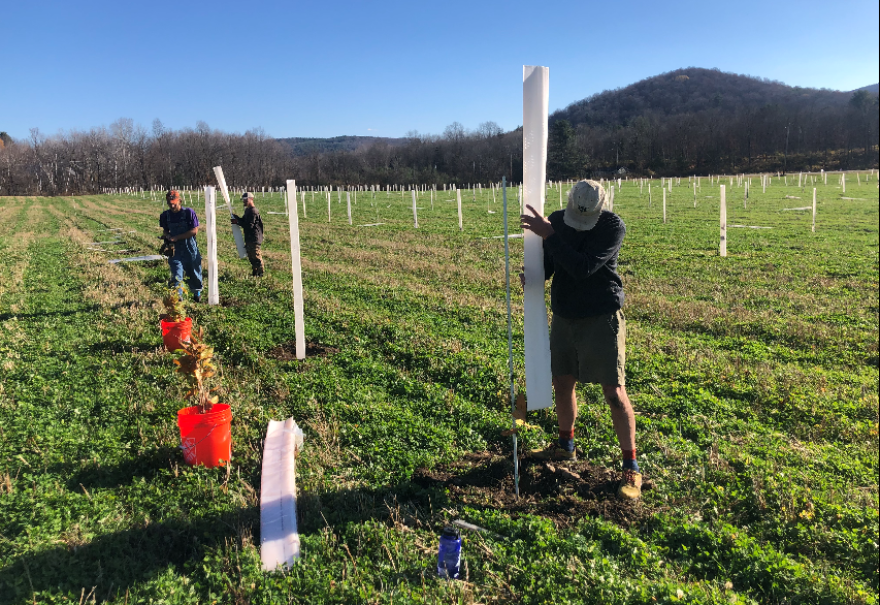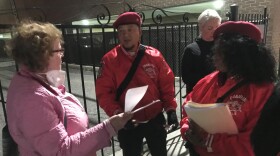My friend Bruce Shenker forwarded me an email about a chestnut tree planting event he was attending in Greenwich, NY last Monday and suggested I join him. We’d have to leave Columbia County by 7:30 to arrive on time for the 9:00 planting demonstration. Correction: due to daylight savings time the demo had been moved up. It was now 8 a.m. In other words we’d have to leave at the crack of dawn.
Bruce generates as much energy before breakfast, after yoga, as I do in an entire month. His day usually includes a run or bike ride in addition to volunteering to perform various manly public-oriented chores, typically in the company of young men with generous beards and zero body fat. Recently, he volunteered to help brush hog the Williams College ski area. Why I’m not entirely sure. He didn’t even attend Williams. We’d met at Middlebury College years ago.
“I walked up 1,000 vertical feet, a 35° slope,” he reported. “That was kind of tiring.”
He celebrated his 70th birthday by spending several days hiking Vermont’s Long Trail with a forty-pound backpack. “My plan was to get to Stowe,” he explained. “I only got halfway there,” before he checked into a hotel.
Undaunted, last weekend I believe it was, Bruce volunteered to help restore the formerly famous New Lebanon train station on the Corkscrew Rail Trail. Charles Dickens is said to have alighted there on one of his reading tours across the United States. “We spent quite a bit of time pulling a tarp over a hole in the roof,” he told me. I can’t remember if that was the same weekend he went orienteering in the Great Barrington hills. And did I mention he’s also the New Lebanon representative to the Columbia County Environmental Management Council?
So when Bruce invited me to join him planting chestnut trees I had a better idea: why doesn’t he plant the trees and tell me how it went? My commitment to participatory journalism is steadfast. But I didn’t see the need to spend eight hours digging holes. “Yes,” Bruce noted without evident animus, “when it switched to 8 and required 6:30 departure I imaged your enthusiasm might wane.”
I was already somewhat acquainted with Breadtree Farms, where the planting was happening and Noah Simon, a managing partner at the farm. Last year I bought three chestnuts from Noah and they’re thriving. Frankly, I had a mercenary motive for considering joining the event. I hoped to come home with several stakes and tubes to protect my trees over the winter, if there were extras. With the help of Deer Off and Japanese beetle traps I’d held off predacious does, fawns and insects over the summer.
I also wanted to interview Noah about chestnut agroforestry and his planting event, which runs through Wednesday, but thought I could do so over the phone without losing too much local color. Bruce could provide that upon his return.
My primary experience of chestnuts is of them roasting over an open fire with Jack Frost nipping at your nose; or warming on New York City food carts alongside the pretzels, which always felt sort of random to me. But Noah explained that they’re a carbohydrate and an important food source around the world. Chestnuts can be ground into flour to make things like pasta and polenta. They can also be spun into an absurdly rich puree that the French consider a delicacy.
Noah’s interest is nothing less than employing chestnuts to help save the planet. “Chestnut agroforestry in the northeast is a scalable way to preserve farmland,” he explained. “A lot of farmland here is in peril. A lot of this land is being sold to solar or housing developers.”
The temperate U.S., he added, is one of the few places in the world that doesn’t have a chestnut industry. There may be a reason why. The trees once blanketed parts of the United States but were wiped out by a fungus in the early 20th century. However, these trees are disease-resistant hybrids. Noah said I could expect my first harvest and my first chestnut puree in three or four years.
The focus of his work, besides building and maintaining his own 120-acre hilltop farm that looks east towards Vermont, is spreading the gospel according to chestnuts. He and his fellow farmers buy and plant orchards that they own and operate. They also engage in long-term leases sharing the chestnut revenue with landowners. Or they’ll design, plant and maintain client-owned orchards and serve as a guaranteed buyer for future yields. You can find more information at Breadtreefarms.com.
Bruce reported that he helped plant 150 trees before lunch. Putting 2,000 seedlings in the ground is the goal. At the end of the day, Bruce emailed me as he was on his way back home. He was headed to the Chatham Brewery for some food and a beer in case I couldn’t wait to retrieve my stakes and tubes. He portrayed his day as a relative breeze because a farmer had lent his auger to drill tree holes. During a planting last spring I take it they did so with picks and shovels.
I’m not proud of myself, but I replied that I was bushed. I’d spent a couple of hours raking and then going for a ten-mile bike ride; the description of Bruce’s typical day before breakfast. I felt a little bit less guilty when Bruce emailed me back. “I’m tired too,” he confessed, “and thinking I will just stay home.”
I still haven’t gotten my tubes and stakes. Bruce was busy making get-out-the-vote calls on Election Day. But he’s coming over for dinner. I figure a free meal is the least he deserves.
Ralph Gardner, Jr. is a journalist who divides his time between New York City and Columbia County. More of his work can be found at ralphgardner.com
The views expressed by commentators are solely those of the authors. They do not necessarily reflect the views of this station or its management.




